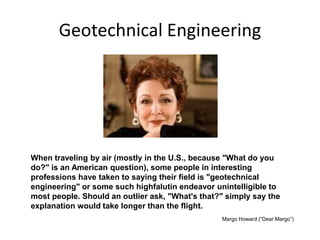Geotheta Fundamentals Explained
Geotheta Fundamentals Explained
Blog Article
Some Of Geotheta
Table of ContentsTop Guidelines Of GeothetaFascination About GeothetaWhat Does Geotheta Do?4 Easy Facts About Geotheta DescribedWhat Does Geotheta Mean?

They carry out website investigations, gather examples, carry out research laboratory examinations, and evaluate data to review the viability of the ground for building and construction projects - Consulting Engineers. Based upon their searchings for, geotechnical engineers offer referrals for structure design, slope stability, preserving frameworks, and mitigation of geotechnical risks. They work together with various other specialists, such as architects, structural engineers, and building teams, to make sure that geotechnical factors to consider are incorporated right into the overall project style and application
By analyzing the behavior and properties of soil and rock, they can identify prospective geotechnical risks such as landslides, soil negotiation, or incline instability. Their know-how aids protect against failings or accidents that can endanger lives and property. Below are some detailed duties and responsibilities of a geotechnical designer: Website Investigation: Geotechnical engineers conduct site investigations to gather information on subsurface conditions.
They translate the data to understand the properties and actions of the soil and rock, including their stamina, leaks in the structure, compaction qualities, and groundwater problems. Geotechnical Evaluation and Design: Geotechnical engineers assess the information collected during site investigations to analyze the stability and viability of the website for building and construction projects. They do geotechnical estimations and modeling to review variables such as bearing ability, negotiation, incline security, side planet pressures, and groundwater flow.
The smart Trick of Geotheta That Nobody is Talking About
Structure Layout: Geotechnical designers play an essential function in designing structures that can safely sustain the designated structure. They assess the dirt conditions and tons requirements to determine the appropriate foundation type, such as superficial structures (e.g., footings), deep structures (e.g (https://www.storeboard.com/geotheta)., piles), or specialized techniques like soil improvement. They consider factors such as settlement limits, birthing capability, and soil-structure interaction to develop optimal foundation designs
They evaluate construction strategies, screen website tasks, and conduct area assessments to validate that the layout suggestions are followed. If unexpected geotechnical concerns emerge, they examine the situation and give recommendations for remediation or modifications to the style. Risk Evaluation and Mitigation: Geotechnical designers examine geotechnical hazards and dangers related to the project website, such as landslides, liquefaction, or soil erosion.

Collaboration and Interaction: Geotechnical designers work closely with various other specialists associated with a job, such as designers, structural designers, and construction groups. Efficient communication and collaboration are essential to integrate geotechnical considerations right into the total job layout and building and construction process. Geotechnical engineers offer technological proficiency, response queries, and make certain that geotechnical demands are met.
Some Known Facts About Geotheta.
Here are some kinds of geotechnical engineers: Structure Designer: Structure designers focus on making and examining structures for frameworks. They assess the soil problems, load demands, and website characteristics to identify the most proper structure kind and layout, such as shallow foundations, deep structures, or specialized methods like stack structures.
They review the variables affecting slope stability, such as soil properties, groundwater conditions, and slope geometry, and establish strategies to avoid incline failings and reduce dangers. Quake Designer: Earthquake engineers focus on analyzing and developing frameworks to hold up against seismic pressures. They examine the seismic threat of a site, examine soil liquefaction possibility, and create seismic design criteria to guarantee the security and durability of structures during quakes.
They perform field testing, accumulate examples, and examine the accumulated information to identify the dirt homes, geologic formations, and groundwater conditions at a site. Geotechnical Instrumentation Designer: Geotechnical instrumentation designers focus on tracking and measuring the actions of dirt, rock, and structures. They mount and preserve instrumentation systems that keep track of elements such as dirt settlement, groundwater degrees, slope motions, and architectural displacements to assess efficiency and offer very early warnings of prospective issues.
The Main Principles Of Geotheta
They conduct examinations such as triaxial tests, debt consolidation tests, straight shear examinations, and leaks in the structure examinations to gather information for geotechnical evaluation and design. Geosynthetics Designer: Geosynthetics designers specialize in the design and application of geosynthetic products, such as geotextiles, geogrids, and geomembranes. They use these materials to boost soil stability, enhance inclines, give drain options, and control disintegration.
They have a tendency to be investigative individuals, which indicates they're intellectual, reflective, and inquisitive. They are curious, methodical, reasonable, logical, and logical. Some of them are likewise social, implying they're kind, generous, cooperative, individual, caring, useful, compassionate, tactful, and pleasant - Geotechnical Engineers.
In the office environment, geotechnical engineers utilize specialized software program tools to do computations, create layouts, and assess data. They prepare records, testimonial job specs, communicate with clients and team members, and coordinate job activities. The workplace setting provides a favorable atmosphere for research, evaluation, and cooperation with various other specialists included in the project.
The smart Trick of Geotheta That Nobody is Talking About
They often visit project sites to conduct website investigations, evaluate geotechnical problems, and gather information for analysis. These check outs entail traveling to different locations, often in remote or challenging surfaces. Geotechnical designers may execute soil sampling, conduct tests, and display construction tasks to guarantee that the geotechnical aspects of the job are being applied properly.
Geotechnical designers additionally operate in specialized geotechnical labs. In these centers, they carry out experiments, do examinations on dirt and rock samples, and evaluate the engineering residential properties of the you can find out more products. Geotechnical laboratory designers work thoroughly in these atmospheres, handling screening tools, running tools, and videotaping information. They work together with various other lab team to make sure precise and trustworthy testing results.
Report this page